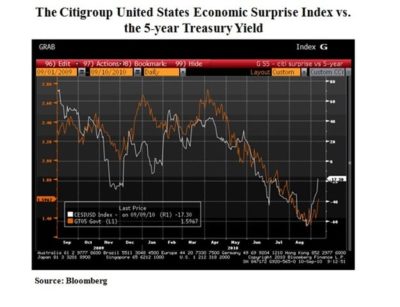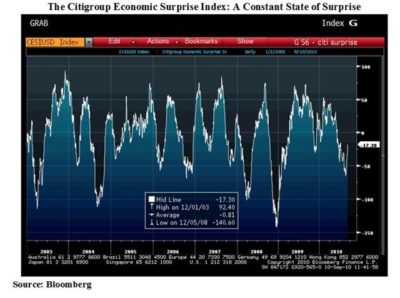Surprise, Surprise
A quick follow up to our recent post on the Great Bond Bubble Debate , which was kicked off by an op-ed piece in the Wall Street Journal by Jeremy Siegel and Jeremy Schwartz. The seductiveness of the Jeremys’ thesis is clear: It makes for a structurally consistent story to say that the bubble in the US financial markets has moved from the junk-bond market in the late ‘80s/early ‘90s to high-tech stocks in the late ‘90s to housing in the mid-2000s to Treasuries in 2010. As it relates to the serial bubble theory, we might add that a feature of any bubble is that capital deployed in the bubble is destroyed in its aftermath….and this is not something that is bound to happen in the Treasury market (you’ll get par back, even if we can’t vouch for what that par is worth). Anyway, in our post, we suggested that ultra-low bond yields weren’t a function of overvaluation, rather they are a rational reflection of inflation expectations.
To follow on that idea, the graph below compares the yield on the five-year Treasury over the past year to an index compiled by Citigroup that measures economic data releases against consensus expectations called the Citigroup Economic Surprise Index (CESI). As defined on Bloomberg, the CESI Indexes “are objective and quantitative measures of economic news, covering all G10 economies. They are defined as weighted historical standard deviations of data surprises (actual releases vs. Bloomberg survey median). A positive reading of the Economic Surprise Index suggests that economic releases have on balance beating [sic] consensus. The indices are calculated daily in a rolling three-month window. The weights of economic indicators are derived from relative high-frequency spot FX impacts of 1 standard deviation data surprises. The indices also employ a time decay function to replicate the limited memory of markets.” The CESI Index below is for the United States.
So when an economic statistic is released, it is measured in terms of its difference from expectations—a big surprise or a small surprise, if you will—and then that surprise is weighted based not only on its importance in the market (we assume the non-farm payroll number carries more weight than, say, the New York Fed’s Empire State Index), it is also measured for the duration of its impact. The graph above tells us two things. First, it tells us that the weakening economy since April was not expected by Wall Street strategists and economists who were largely looking for a continued economic recovery. Second, it tells us that market participants traded the surprises in a rational way, i.e., if the economy is turning out to be weaker than originally thought, then bonds should be bid up. And the latest up turn seem to suggest that perhaps the market has got too bearish on the economy and yields are acting accordingly. Therefore, we aren’t in a bubble, but we are in a weak, disinflationary economic environment.
Before we start over-relying on the predictive nature of the CESI, however, we want to point out that the relationship is better correlated in some periods than others. In addition, for what it’s worth, if the consensus were an accurate predictor of the future, then the CESI would always be close to zero. As the graph below shows, the consensus is often surprised by the facts and holds onto a bullish stance a lot more easily than a bearish one. This may explain why the index is skewed more towards deeper downside surprises.


Comments are closed.